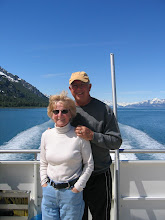Port Angeles, Washington State to San Diego, California
On September 12, 2014, we left Port Angeles, Wa. heading to San Diego. This is a journey of 1200+ miles at a speed of 9-11 mph or about 9 knots per hour. Can you imagine being on the freeway going 1200 miles at 10 mph??? We first traveled west on the Strait of Juan de Fuca and spent the night in a small native american village called Neah Bay. This is about 5 miles east of Cape Flattery, the furthest west and north corner of the United States. As you reach the cape, you make a hard left turn heading south down the west coast of the U.S. Our first "leg" was 241 miles to Newport, Oregon. We left Neah Bay at 0630 and arrived Newport Oregon at 1000 the next morning. Yes, we ran in the dark, overnight, to make this trip. We spent the night of the 13th in Newport, and then went back out on the 14th. Destination, Eureka, California, 237 miles. We left at 0600 in the dark, and arrived on the 15th in Eureka at 1100 hours. We sat in Eureka for 6 days waiting for favorable weather down the coast of California. We rented a car here, spent time with the hippies in Arcata, home of Humboldt State University. What a great spot. Found a wonderful coffee/pastry shop here. (our dietary weakness).
Finally on September 21 at 0600 we left, next stop Monterey, Ca., a trip of 290 miles. We arrived Monterey the next day, the 22nd, at 1400. Monterey, Ca. is just a GREAT city. If you ever have a chance, you must visit here, if you haven't already done so. We stayed in Monterey until October 17th, just having fun and waiting for good weather.
Our next leg was 119 miles where we anchored in a harbor called San Luis. We arrived in the dark, and anchored in a spot using radar and GPS. We were tired after a 13 hour run. But the next morning we were up before daylight heading out. Our destination this time was Santa Barbara, Ca. a trip of only 89 miles. BUT, when leaving San Luis heading south you arrive at the Cape of Good Hope of the United States called Point Conception, where winds, waves and currents all collide. This HAS to be done in good weather, which we had! Then you turn due east heading to Santa Barbara. We arrived there mid afternoon, but the marina was full. We anchored off the pier in extremely light winds. That night, the 18th, was one of the worse nights of our boating career. The waves were only one foot with light winds, but our boat turned sideways to the wave, and we rolled, and rolled, and rolled and rolled. Miserable night.
When we left Santa Barbara, we then went to Ventura, Marina Del Rey in Los Angeles, and then into San Diego to our winter slip at the Sheraton Hotel, on Harbor Island. A very nice spot where we have enjoyed the amenities of the hotel such as restaurants, swimming pool, hot tub, gym, and spa. Extremely nice.
So to recap!
Our trip from Washington State to Alaska, tour Alaska, and back to Washington State was 2,076 miles. Then 1,208 miles to San Diego. Grand total miles at 3,284. We burned 2,722 gallons of diesel, at an average price of $4.07 per gallon, for a total cost of $11,072. Our average MPG was 1.21. In the boating world this isn't too bad!
Our plans as I write this in early March 2015 is to head north from San Diego April 1st. Destination, Alaska again! We can't get enough of Alaska, it is really our home now. Other than our home in San Diego is where all our family is located! Who knows how long this trip will take, but our goal is to arrive Alaska by June 1st. We have learned though to only travel when the weather is favorable. This is the key. Stay tuned for this next story.
Chuck and Margaret






